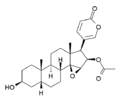Cinobufagin
Cinobufagin[edit]
Cinobufagin is a bufadienolide compound found in the skin secretions of certain toads, particularly those of the genus Bufo. It is known for its potent cardiotonic and antineoplastic properties. This article provides an overview of the chemical structure, pharmacological effects, and potential therapeutic applications of cinobufagin.
Chemical Structure[edit]
Cinobufagin is a type of steroid with a molecular formula of C26H34O6. It is classified as a bufadienolide due to its characteristic lactone ring structure. The compound is structurally similar to other cardiac glycosides, such as digoxin, but differs in its specific configuration and functional groups.
Sources[edit]
Cinobufagin is primarily extracted from the skin and parotid gland secretions of toads belonging to the Bufo genus, such as Bufo bufo gargarizans and Bufo melanostictus. These secretions have been used in traditional Chinese medicine under the name "Chan Su" for their purported therapeutic effects.
Pharmacological Effects[edit]
Cinobufagin exhibits a range of pharmacological activities, including:
- Cardiotonic Effects: Cinobufagin acts on the sodium-potassium pump (Na⁺/K⁺-ATPase) in cardiac cells, leading to increased intracellular calcium levels. This enhances cardiac contractility, making it a potent cardiotonic agent.
- Antineoplastic Activity: Studies have shown that cinobufagin can induce apoptosis in various cancer cell lines, including hepatocellular carcinoma and lung cancer cells. It is believed to exert its antitumor effects through the modulation of signaling pathways such as PI3K/AKT and MAPK.
- Anti-inflammatory Effects: Cinobufagin has been reported to reduce inflammation by inhibiting the production of pro-inflammatory cytokines and mediators.
Therapeutic Applications[edit]
While cinobufagin has shown promise in preclinical studies, its clinical use is limited due to its narrow therapeutic index and potential toxicity. Research is ongoing to develop safer derivatives and formulations that can harness its therapeutic potential.
Traditional Medicine[edit]
In traditional Chinese medicine, cinobufagin-containing preparations are used for their purported benefits in treating heart failure, pain, and certain types of cancer. However, these uses are not widely accepted in Western medicine due to the lack of rigorous clinical trials.
Safety and Toxicity[edit]
Cinobufagin, like other cardiac glycosides, can be toxic at high doses. Symptoms of toxicity include nausea, vomiting, arrhythmias, and cardiac arrest. Careful dosing and monitoring are essential when using cinobufagin therapeutically.
Research and Development[edit]
Ongoing research aims to better understand the mechanisms of action of cinobufagin and to develop novel drug delivery systems that can improve its safety profile. Studies are also exploring its potential synergistic effects with other anticancer agents.
See Also[edit]
References[edit]
<references group="" responsive="1"></references>
External Links[edit]
-
Cinobufagin
Ad. Transform your life with W8MD's Budget GLP-1 injections from $75


W8MD offers a medical weight loss program to lose weight in Philadelphia. Our physician-supervised medical weight loss provides:
- Weight loss injections in NYC (generic and brand names):
- Zepbound / Mounjaro, Wegovy / Ozempic, Saxenda
- Most insurances accepted or discounted self-pay rates. We will obtain insurance prior authorizations if needed.
- Generic GLP1 weight loss injections from $75 for the starting dose.
- Also offer prescription weight loss medications including Phentermine, Qsymia, Diethylpropion, Contrave etc.
NYC weight loss doctor appointmentsNYC weight loss doctor appointments
Start your NYC weight loss journey today at our NYC medical weight loss and Philadelphia medical weight loss clinics.
- Call 718-946-5500 to lose weight in NYC or for medical weight loss in Philadelphia 215-676-2334.
- Tags:NYC medical weight loss, Philadelphia lose weight Zepbound NYC, Budget GLP1 weight loss injections, Wegovy Philadelphia, Wegovy NYC, Philadelphia medical weight loss, Brookly weight loss and Wegovy NYC
|
WikiMD's Wellness Encyclopedia |
| Let Food Be Thy Medicine Medicine Thy Food - Hippocrates |
Medical Disclaimer: WikiMD is not a substitute for professional medical advice. The information on WikiMD is provided as an information resource only, may be incorrect, outdated or misleading, and is not to be used or relied on for any diagnostic or treatment purposes. Please consult your health care provider before making any healthcare decisions or for guidance about a specific medical condition. WikiMD expressly disclaims responsibility, and shall have no liability, for any damages, loss, injury, or liability whatsoever suffered as a result of your reliance on the information contained in this site. By visiting this site you agree to the foregoing terms and conditions, which may from time to time be changed or supplemented by WikiMD. If you do not agree to the foregoing terms and conditions, you should not enter or use this site. See full disclaimer.
Credits:Most images are courtesy of Wikimedia commons, and templates, categories Wikipedia, licensed under CC BY SA or similar.
Translate this page: - East Asian
中文,
日本,
한국어,
South Asian
हिन्दी,
தமிழ்,
తెలుగు,
Urdu,
ಕನ್ನಡ,
Southeast Asian
Indonesian,
Vietnamese,
Thai,
မြန်မာဘာသာ,
বাংলা
European
español,
Deutsch,
français,
Greek,
português do Brasil,
polski,
română,
русский,
Nederlands,
norsk,
svenska,
suomi,
Italian
Middle Eastern & African
عربى,
Turkish,
Persian,
Hebrew,
Afrikaans,
isiZulu,
Kiswahili,
Other
Bulgarian,
Hungarian,
Czech,
Swedish,
മലയാളം,
मराठी,
ਪੰਜਾਬੀ,
ગુજરાતી,
Portuguese,
Ukrainian
